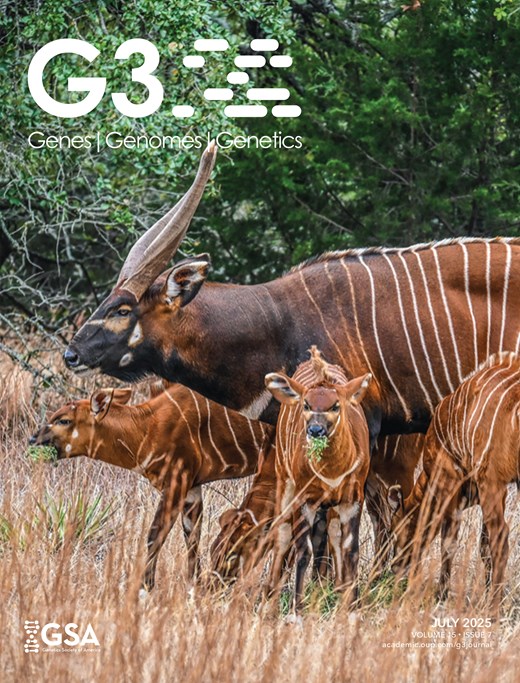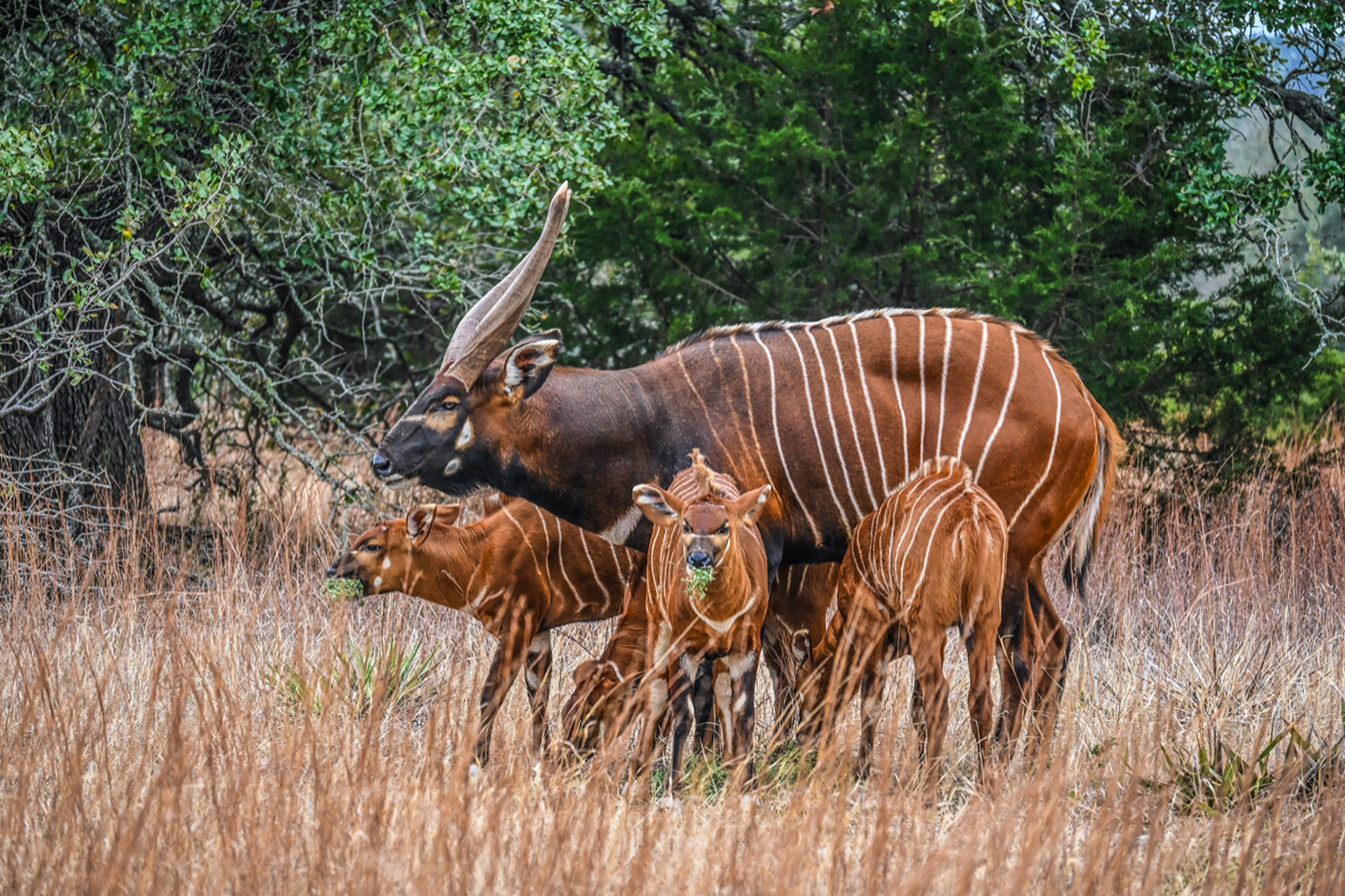
Cover image
 An adult male Mountain bongo (Tragelaphus eurycerus isaaci) watches over bongo calves while eating. As one of the rarest antelope species in the world, the Mountain Bongo is the focus of extensive conservation efforts in Kenya. The genome assembly presented in this volume supports genetic management of ex situ populations and the long-term survival of wild populations of this critically endangered species. Image courtesy of Jade Schuster. See Holm et al., https://doi.org/10.1093/g3journal/jkaf109.
An adult male Mountain bongo (Tragelaphus eurycerus isaaci) watches over bongo calves while eating. As one of the rarest antelope species in the world, the Mountain Bongo is the focus of extensive conservation efforts in Kenya. The genome assembly presented in this volume supports genetic management of ex situ populations and the long-term survival of wild populations of this critically endangered species. Image courtesy of Jade Schuster. See Holm et al., https://doi.org/10.1093/g3journal/jkaf109.
Volume 15, Issue 7, July 2025
Investigation
Targeted single cell expression profiling identifies integrators of sleep and metabolic state
A whole-genome scan for evidence of positive and balancing selection in aye-ayes (Daubentonia madagascariensis) utilizing a well-fit evolutionary baseline model
In this work, Soni et al. present the first whole-genome scan for evidence of recent positive and balancing selection in aye-ayes. This research was enabled by three recent developments: 1) the authors’ generation of high-quality genomic data from these wild caught individuals; 2) the recent annotation of the chromosome-level aye-aye genome; and 3) the recent estimation of a demographic history for this population. Utilizing these new resources, they provide intriguing insights into the landscape of episodic selective forces operating in this highly endangered species, and present compelling evidence of positive and balancing selection uniquely targeting genes involved in both olfaction and spermatogenesis.
A single high-zinc activation enhancer can control two genes oriented head-to-head in Caenorhabditis elegans
Transposable elements and heterochromatic regions are enriched for structural variation and sequence divergence in the genome of wild-type Caenorhabditis elegans
Systems genetics reveals the influence of expression QTLs in mouse embryonic stem cells on transcriptional variation later in differentiated neural progenitor cells
QTL identification and characterization of the recombination landscape of the mountain pine beetle (Dendroctonus ponderosae)
The Drosophila nucleoporin ELYS is required for parental chromosome arrangement at fertilization
Large effect life-history genomic regions are associated with functional morphological traits in Atlantic salmon
The contribution of two major effect life-history loci (vgll3 and six6) to functional morphological variation was quantified. Using 800 Atlantic salmon juveniles from 28 full-sib families, reared in a common garden setting, 21 morphological traits linked to resource acquisition and foraging efficiencies were measured, and the proportion of locus-specific variation was estimated. The results showed that vgll3 is linked to swimming performance traits, while six6 shapes head and body size, which suggest that a complex morphological landscape is associated with life-history loci, and that life-history loci in Atlantic salmon has broad regulatory roles across the multiple life-stages.
Disrupted development of sensory systems and the cerebellum in a zebrafish ebf3a mutant
Site-to-site mutational dissection of fission yeast cohesin reveals its dynamics
A reaction norm for flowering time plasticity reveals physiological footprints of maize adaptation
Maize adjusts its flowering time across environments through physiological responses to cues like temperature and day length. This study models how different varieties perceive and react to these factors, revealing that genotypes can experience the same environment in distinct ways. By disentangling the ecophysiological basis of genotype-environmental interactions, the research explores maize diversity and highlights how adaptation and breeding have shaped distinct strategies for flowering time regulation in tropical and temperate varieties.
Optimization of recurrent rapid cycle breeding in maize for sustained long-term genetic improvement via stochastic simulations
Whole-genome resequencing of a global collection of Napier grass (Cenchrus purpureus) to explore global population structure and QTL governing yield and feed quality traits
Napier grass (Cenchrus purpureus) is a perennial grass species native to Sub-Saharan Africa (SSA), primarily used to feed cattle in SSA. The authors’ resequencing study provided valuable insights into the genetic diversity across a global Napier grass collection. Furthermore, a genome-wide association study on two independent populations, identified multiple quantitative trait loci (QTL) that were significantly associated with desirable agronomic traits. Therefore, their results will serve as a valuable resource to spearhead genomics-based breeding programs to develop high-yielding and drought-tolerant varieties.
Gene expression and pollen performance indicate altered postmating selection between Solanum species with different mating systems
Phenological variation associates with the stability of fruit quality traits in cultivated tetraploid blueberry
Genome Reports
Chromosome-level genome assembly of Protandrena (Anthemurgus) passiflorae (Hymenoptera: Andrenidae), a host-plant specialist bee
Scientists from the USDA-ARS' Beenome100 project report the genome assembly of the passionflower bee, Protandrena passiflorae, a host-plant specialist of a passionflower plant. This genome is the first Protandrena species to be sequenced and assembled at a chromosome scale, and one of a few available in the bee family, Andrenidae. High-fidelity sequencing of the entire genome using PacBio, along with HiC sequencing, and short-read RNA sequencing data led to a comprehensive chromosome level assembly that is >97% complete. This assembly showcases producing efficient, comprehensive, and continuous genome arrangements from a single specimen.
Genome report: whole-genome assembly of the relapsing fever tick Ornithodoros turicata Dugès (Acari: Argasidae)
Chromosome-length genome assembly of the critically endangered Mountain bongo (Tragelaphus eurycerus isaaci): a resource for conservation and comparative genomics
The Mountain bongo (Tragelaphus eurycerus isaaci), a critically endangered antelope native to Kenya, is under threat from habitat loss and hunting. Using a combination of genome sequencing technologies, Holm et al. generated the first chromosome-length genome assembly for the species, which they then annotated and evaluated in relation to two previous assemblies of this species. This reference assembly will be used to investigate questions related to genome-wide genetic diversity, genetic structure, inbreeding, and the burden of deleterious variation in both in-situ and ex-situ populations, thereby providing vital information to inform and guide ongoing conservation efforts.


